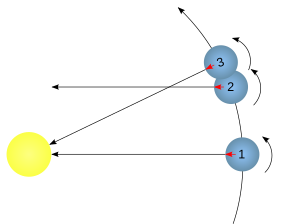
Back توقيت شمسي Arabic Сярэдні сонечны час Byelorussian सौर समय Bihari Temps solar Catalan Sluneční čas Czech Soltid Danish Sonnenzeit German Ηλιακός χρόνος Greek Suntempo Esperanto Tiempo solar Spanish

Solar time is a calculation of the passage of time based on the position of the Sun in the sky. The fundamental unit of solar time is the day, based on the synodic rotation period. Traditionally, there are three types of time reckoning based on astronomical observations: apparent solar time and mean solar time (discussed in this article), and sidereal time, which is based on the apparent motions of stars other than the Sun.[1]
- ^ For the three kinds of time, see (for example) the explanatory section in the almanac Connaissance des Temps for 1902, page 759 Archived August 10, 2011, at the Wayback Machine.
© MMXXIII Rich X Search. We shall prevail. All rights reserved. Rich X Search